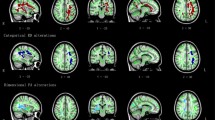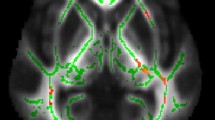Abstract
Aberrant microstructure of the callosal tracts has been found in boys with attention-deficit/hyperactivity disorder (ADHD). However, it is unclear whether the previously identified white matter (WM) alterations in boys with ADHD are also present in girls with ADHD. Thus, we applied diffusion tensor imaging (DTI) to investigate WM alterations in the callosal tracts in girls with ADHD. In this study, twenty-four adolescent girls (fourteen ADHD patients and ten typically developed girls) were recruited for high-resolution DTI. Automated fiber quantification of the callosum forceps major and the callosum forceps minor was then conducted. Diffusion parameters, including fractional anisotropy (FA), mean diffusivity (MD), radial diffusivity (RD) and axial diffusivity (AD), were calculated to investigate the microstructural integrity of the two callosal tracts. We also investigated correlations between diffusion properties and clinical measurements, including scores on Conners’ Parent Rating Scale, the Stroop Color-Word Test, the Wisconsin Card Sorting Test and the Continuous Performance Test, in ADHD patients and typically developed girls. Compared to typically developed adolescent girls, girls with ADHD had reduced FA values at nodes 59–70 and increased RD values at nodes 60–68 along the callosum forceps major. Lower FA values correlated with higher Hyperactivity–Impulsivity scores and lower control quotients, while higher RD values correlated with lower control quotients. This study revealed the disruption of interhemispheric connectivity, particularly across the right side of the occipital CC tract, which might be involved in visual processes in girls with ADHD. These findings enhanced current knowledge about the neuropathological basis of female ADHD.


Similar content being viewed by others
References
Ahrendts, J., Rusch, N., Wilke, M., Philipsen, A., Eickhoff, S. B., Glauche, V., et al. (2011). Visual cortex abnormalities in adults with ADHD:A structural MRI study. The World Journal of Biological Psychiatry, 12, 260–270.
Anderson, J. C., Williams, S., McGee, R., & Silva, P. A. (1987). DSM-III-R disorders in preadolescent children: Prevalence in a large sample from the general population. Archives of General Psychiatry, 44, 69–76.
Aoki, Y., Cortese, S., & Castellanos, F. X. (2017). Diffusion tensor imaging studies of attention-deficit/hyperactivity disorder: Meta-analyses and reflections on head motion. Journal of Child Psychology and Psychiatry, 59, 193–202. https://doi.org/10.1111/jcpp.12778.
Basser, P. J., Pajevic, S., Pierpaoli, C., Duda, J., & Aldroubi, A. (2000). In vivo fiber tractography using DT-MRI data. Magnetic Resonance in Medicine, 44, 625–632.
Baumgartel, A., Wolraich, M. L., & Dietrich, M. (1995). Comparison of diagnostic criteria for attention deficit disorders in a German elementary school sample. Journal of the American Academy of Child and Adolescent Psychiatry, 34, 629–638.
Bellis, T. J., Billiet, C., & Ross, J. (2008). Hemispheric lateralization of bilaterally presented homologous visual and auditory stimuli in normal adults, normal children, and children with central auditory dysfunction. Brain and Cognition, 66, 280–289.
Cabeza, R., & Nyberg, L. (2000). Imaging cognition II: An empirical review of 275 PET and fMRI studies. Journal of Cognitive Neuroscience, 12(1), 1–47.
Chen, L., Hu, X., Ouyang, L., He, N., Liao, Y., Liu, Q., Zhou, M., Wu, M., Huang, X., & Gong, Q. (2016). A systematic review and meta-analysis of tract-based spatial statistics studies regarding attention-deficit/hyperactivity disorder. Neuroscience and Biobehavioral Reviews, 68, 838–847. https://doi.org/10.1016/j.neubiorev.2016.07.022.
Conners, C. K., Sitarenios, G., Parker, J. D., et al. (1998). The revised Conners’Parent rating scale (CPRS-R): Factor structure, reliability, and criterion validity. Journal of Abnormal Child Psychology, 26, 257–268.
Cortes, S., Kelly, C., Chabernaud, C., Proal, E., Martino, A. D., Milham, M. P., et al. (2012). Toward systems neuroscience of ADHD: A meta-analysis of 55 fMRI studies. AmJPsychiatry, 169, 1038–1055.
DeYoe, E. A., Felleman, D. J., Van Essen, D. C., & McClendon, E. (1994). Multiple processing streams in the occipitotemporal visual cortex. Nature, 371(6493), 151–154.
Dramsdahl, M., Westerhausen, R., Haavik, J., Hugdahl, K., & Plessen, K. J. (2012). Adults with attention-deficit/hyperactivity disorder - a diffusion-tensor imaging study of the corpus callosum. Psychiatry Research, 201(2), 168–173. https://doi.org/10.1016/j.pscychresns.2011.08.005.
Gazzaniga, M. S. (2000). Cerebral specialization and interhemispheric communication: Does the corpus callosum enable the human condition. Brain, 123(Pt 7), 1293–1326.
Giedd, J. N., Blumenthal, J., Molloy, E., & Castellanos, F. X. (2001). Brain imaging of attention deficit/hyperactivity disorder. Annals of the New York Academy of Sciences, 931, 33–49.
Gong, Y., & Cai, T. (1993). Manual of chinese revised wechsler interlligence scale for children. changsha: human atlas publishing house.
Hale, T. S., Kane, A. M., Kaminsky, O., et al. (2014a). Visual network asymmetry and default mode network function in ADHD: An fMRI study. Frontiers in Psychiatry, 5, 81–81.
Hale, T. S., Kane, A. M., Tung, K. L., Kaminsky, O., McGough, J. J., Hanada, G., et al. (2014b). Abnormal parietal brain function in ADHD: Replication and extension of previous EEG beta asymmetry findings. FrontPsychiatry, 5, 87.
Hutchinson, A. D., Mathias, J. L., & Banich, M. T. (2008). Corpus callosum morphology in children and adolescents with attention deficit hyperactivity disorder: A meta-analytic review. Neuropsychology, 22(3), 341–349.
Jacobson, L. A., Peterson, D. J., Rosch, K. S., Crocetti, D., Mori, S., & Mostofsky, S. H. (2015). Sex-based dissociation of white matter microstructure in children with attention-deficit/hyperactivity disorder. Journal of the American Academy of Child and Adolescent Psychiatry, 54(11), 938–946.
Johnson, R. T., Yeatman, J. D., Wandell, B. A., Buonocore, M. H., Amaral, D. G., & Nordahl, C. W. (2013). Diffusion properties of major white matter tracts in young, typically developing children. Neuroimage, 88C, 143–154.
Lischke, A., Domin, M., Freyberger, H. J., et al. (2017). Structural alterations in the Corpus callosum are associated with suicidal behavior in women with borderline personality disorder. Frontiers in Human Neuroscience, 11(196).
Mori, S. C. B., Chacko, V., & Van Zijl, P. (1999). Three-dimensional tracking of axonal projections in the brain by magnetic resonance imaging. Annals of Neurology, 45, 265–269.
Nagel, B. J., Bathula, D., Herting, M., et al. (2011). Altered white matter microstructure in children with attention-deficit/hyperactivity disorder. J Am Acad Child Adolesc Psychiatry Res, 50, 283–292.
Nelson, H. E. (1976). A modifed card sorting test sensitive to frontal lobe defects. Cortex, 12, 313–324.
Nichols, T. E., & Holmes, A. P. (2002). Nonparametric permutation tests for functional neuroimaging: A primer with examples. Human Brain Mapping, 15, 1–25.
Paolozza, A., Treit, S., Beaulieu, C., & Reynolds, J. N. (2014). Response inhibition deficits in children with fetal alcohol Spectrum disorder: Relationship between diffusion tensor imaging of the corpus callosum and eye movement control. Neuroimage Clin, 5, 53–61.
Perchet, C., Revol, O., Fourneret, P., Mauguiere, F., & Garcia-Larrea, L. (2001). Attention shifts and anticipatory mechanisms in hyperactive children: An ERP study using the Posner paradigm. Biol Psychiatry Res, 50, 44–57.
Polanczyk, G., de Lima, M. S., Horta, B. L., et al. (2007). The worldwide prevalence of ADHD: A systematic review and metaregression analysis. American Journal of Psychiatry, 164(6), 942–948.
Putnam, M. C., Steven, M. S., Doron, K. W., Riggall, A. C., & Gazzaniga, M. S. (2010). Cortical projection topography of the human splenium: Hemisphericasymmetry and individual differences. Journal of Cognitive Neuroscience, 22, 1662–1669.
Solberg, B. S., Halmøy, A., Engeland, A., Igland, J., Haavik, J., & Klungsøyr, K. (2017). Gender differences in psychiatric comorbidity: A population-based study of 40 000 adults with attention deficit hyperactivity disorder. Acta Psychiatr Scand, 1-11.
Sowell, E. R., Thompson, P. M., Welcome, S. E., Henkenius, A. L., Toga, A. W., & Peterson, B. S. (2003). Cortical abnormalities in children and adolescents with attention-defi cit hyperactivity disorder. Lancet, 362, 1699–1707.
Stelt, O. V. D., Molen, M. V. D., Gunning, W. B., et al. (2001). Neuroelectrical signs of selective attention to color in boys with attention-defi cit hyperactivity disorder. Cognitive Brain Research, 12(2), 245–264.
Tamm, L., Barnea-Goraly, N., & Reiss, A. L. (2012). Diffusion tensor imaging reveals white matter abnormalities in attention-deficit/hyperactivity disorder. Psychiatry Research, 202(2), 150–154. https://doi.org/10.1016/j.pscychresns.2012.04.001.
Tinius, T. P. (2003). The integrated visual and auditory continuous performance test as a neuropsychological measure. Archives of Clinical Neuropsychology, 18(5), 439–454.
Valera, E. M., Faraone, S. V., Murray, K. E., & Seidman, L. J. (2007). Meta-analysis of structural imaging findings in attention-deficit/hyperactivity disorder. Biological Psychiatry, 61(12), 1361–1369.
van Ewijk, H., Heslenfeld, D. J., Zwiers, M. P., Buitelaar, J. K., & Oosterlaan, J. (2012). Diffusion tensor imaging in attention deficit/hyperactivity disorder: A systematic review and meta-analysis. Neuroscience and Biobehavioral Reviews, 36(4), 1093–1106. https://doi.org/10.1016/j.neubiorev.2012.01.003.
Wakana, S., Caprihan, A., Panzenboeck, M. M., Fallon, J. H., Perry, M., Gollub, R. L., Hua, K., Zhang, J., Jiang, H., Dubey, P., Blitz, A., van Zijl, P., & Mori, S. (2007). Reproducibility of quantitative tractography methods applied to cerebral white matter. Neuroimage, 36(3), 630–644. https://doi.org/10.1016/j.neuroimage.2007.02.049.
Wang, J., Jiang, T., Cao, Q., & Wang, Y. (2007). Characterizing anatomic differences in boys with attention-deficit/hyperactivity disorder with the use of deformation-based morphometry. AJNR. American Journal of Neuroradiology, 28(3), 543–547.
Willcutt, E. G. (2012). The prevalence of DSM-IV attention deficit/hyperactivity disorder: A meta-analytic review. neurotherapeutics, 9(3), 490–499.
Yeatman, J. D., Dougherty, R. F., Myall, N. J., Wandell, B. A., & Feldman, H. M. (2012). Tract profiles of white matter properties: Automating fiber-tract quantification. PLoS One, 7(11), e49790. https://doi.org/10.1371/journal.pone.0049790.
Acknowledgments
The authors are grateful to the patients and control subjects for their participation in the study and to our colleagues who facilitated the work. This study was supported by grants from the National Natural Science Foundation of China (Grant No. 81671669), the Natural Science Foundation of Zhejiang Province (Grant No. LY14H090012), and the Sichuan Youth Science and Technology Foundation (Grant No. 2017JQ0001). The funders had no role in the study design, data collection and analysis, the decision to publish, or the preparation of the manuscript.
Author information
Authors and Affiliations
Contributions
QL, XB, XH and CY designed the study, contributed to data analysis, interpreted the data and wrote the manuscript; MW, YL, HC, WW, YY, and HL contributed to data acquisition and processing; XH and CY contributed to study supervision, obtained funding, and reviewed and commented on the first draft of the manuscript; and JZ, LL and XH assisted with data analysis and interpretation of findings. All authors critically reviewed and approved the final version of the manuscript submitted for publication.
Corresponding author
Ethics declarations
Ethical statement
All procedures performed in studies involving human participants were performed in accordance with the ethical standards of the institutional and/or national research committee and with the 1964 Helsinki Declaration and its later amendments or comparable ethical standards.
Conflict of interest
The authors declare that the research was conducted in the absence of any commercial or financial relationships that could be construed as a potential conflict of interest.
Informed consent
Informed consent was obtained from all individual participants included in the study.
Additional information
Publisher’s Note
Springer Nature remains neutral with regard to jurisdictional claims in published maps and institutional affiliations.
Rights and permissions
About this article
Cite this article
Lin, Q., Bu, X., Wang, M. et al. Aberrant white matter properties of the callosal tracts implicated in girls with attention-deficit/hyperactivity disorder. Brain Imaging and Behavior 14, 728–735 (2020). https://doi.org/10.1007/s11682-018-0010-2
Published:
Issue Date:
DOI: https://doi.org/10.1007/s11682-018-0010-2




